«previous pageGENERAL DESIGN CATEGORY
Honor Award
HtO, Toronto, Ontario, Canada
Janet Rosenberg + Associates (JRA), Toronto, Ontario, Canada;
Claude Cormier Architectes Paysagistes, Montreal, Quebec, Canada;
Hariri Pontarini Acrhitects, Toronto, Ontario, Canada
client: City of Toronto
Project Statement
HtO, an urban beach along Toronto’s waterfront, is not only an adored, seasonally adaptive public space where people can relax by the water away from downtown commotion, but it is also a catalyst for the city’s future waterfront development, having set high design standards. Transformed from an abandoned industrial site, the park is a welcoming, branded destination for the local community and for tourists, effectively drawing visitors and animating the waterfront with color and activity.
Project Narrative
Toronto’s Central Waterfront is disconnected from the rest of the city by an elevated expressway. HtO was created to draw people to the water, entice them with a unique yet flexible design for passive and active uses, and therefore eliminate these barriers between the downtown and Lake Ontario. Since its opening, the park has attracted countless visitors during all seasons and has proven to be a much needed public space. HtO has also played a key role in knitting together other destinations along the waterfront.
Project Location, Scope & Size
Completed in June 2007, HtO sits on approximately six acres of land just east of the Spadina Street slip in downtown Toronto’s Central Waterfront community. The park is divided by a slip into two sections: the eastern side is adjacent to a local Fire Station while the western side is next to a condominium building. The design of HtO was a winning entry in an international design competition. The park consists of a boardwalk along the edge, a sand beach with tall yellow umbrellas, and sodded berms amid paved paths.
Site & Context Investigation
Toronto’s entire waterfront spans about 46 kilometers from Etobicoke Creek in the west to the Rouge River in the east. For many years it functioned as an important industrial area, providing shipping access, which accounts for the presence of many slips. With the creation of an elevated expressway (the Gardiner) that runs alongside the Central Waterfront in downtown Toronto and provides access to surrounding suburbs, as well as due to an expanded development of the downtown lands, industrial companies slowly moved out of the central district and sought cheaper locations in the suburbs. As a result, the Central Waterfront was left with many abandoned sites that were heavily polluted.
Since the early 1970s Toronto has experienced a steady revitalization of the Central Waterfront with the development of condominiums, parks, and recreational centres, among many things. Presently, the Central Waterfront is challenged by an ever growing wall of condominium towers and a disconnection between the downtown and the lake because of the Gardiner. HtO park, like many other open space projects along Toronto’s shore, was sought to revitalize a neglected and derelict industrial site, address issues of soil contamination, and help to invite people towards the water thereby reconnecting Toronto with its beautiful lake.
Design Program
Because HtO is located in downtown Toronto and is steps away from destinations such as the Harbourfront Centre, the Queen’s Quay Terminal, and various hotels and residences, it provides an ideal stage for programmable activities. Most recently, HtO was host to an outdoor reception at the famous Toronto Film Festival, for instance, and this coming June it will be the destination for a popular local festival of arts, Luminato. In addition, the neighbouring Harbourfront Centre holds numerous indoor and outdoor events throughout the year, which attract many people to the area. HtO helps to accommodate the resulting large pedestrian inflow.
Design Intent
HtO creates a more fluid passage between the downtown and the waterfront, visually and functionally. Visually, the topography of the park allows visitors to go uphill through the green berms as they enter the park and then they descend down towards the beach and the lake, thereby creating the sense that the city and the elevated expressway are left behind. Functionally, the park draws people to the waterfront by providing sufficient opportunities for shaded relaxation or leisurely activities. Unlike anywhere else within walking distance, visitors to the park can spend the day sun tanning, picnicking or bike riding for example in a space that makes unique use of hard and soft surfaces.
HtO has also helped to establish a new language along the waterfront. It was the first park to be completed in the area for some years and it set the tone for the development of public open spaces that is currently happening at Toronto’s waterfront. The urban beach became very iconic both from street level and from aerial views, giving a new identity to the community. The name HtO itself has been devised as a branding tactic that helps to position the park as an important addition in the sequence of public spaces along Lake Ontario.
Materials & Installation Methods
The materials used in the park (sand, long grasses, willows) are associated with a beach setting but because HtO is an “urban” beach, the design also makes use of concrete, sod, and perforated umbrellas. One of the major considerations in the completion of the park was its extension into the lake. Complex engineering processes were used to enable the park to cantilever over the water thereby extending its surface area.
Environmental Impact & Concerns
HtO sits on a site with history and a legacy of environmental damage. The design had to address issues of soil contamination and other remnants of industrial progress. Capping was used to leave contaminated soils undisturbed rather than shipping them off elsewhere. On-site storm water management systems were put in place such as pervious surfaces that infiltrate water and gradually dispersing infiltration pits. In addition, all the water that is used for irrigation is lake water. To revive some of the natural ecologies in the lake, fish habitats were built along the edge of the park and in the slip using recycled concrete from the site and rip-rap.
Collaboration with Client & Other Designers
The design team consisted of two landscape architecture firms and an architect who worked closely with the client on the project, taking it from design through to completion. The client and the design team also worked alongside a prominent lighting designer to incorporate dramatic lighting design for the park. The project also required extensive public consultation, which was led by the landscape architect.
Project Resources
Lighting Designer
Leni Schwendinger Light Projects Ltd.
Communications Consultant
Beth Kapusta
Engineer
Carruthers & Wallace Ltd.
Engineer
Stantec Consulting Ltd.
Art Consultant
Rina Greer
Historian
William Greer
Contractor
Somerville Construction
Featured Products
Paving
Il Campo Pavers, Unilock
Landscape Lighting
Lumec Light Columns
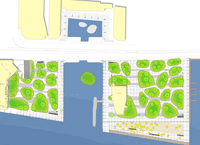
Site Plan. (Photo: JRA)
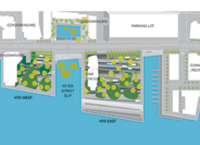
Contextual plan (original design). (Photo: JRA/Claude Cormier Architectes Paysagistes)
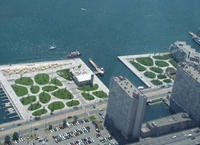
Aerial view of HtO. (Photo: JRA)
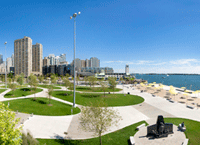
Panoramic view of HtO east. (Photo: Neil Fox)
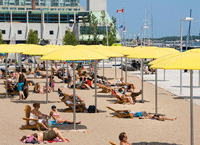
Visitors spending the day on the urban beach shaded by tall yellow umbrellas. (Photo: Neil Fox)
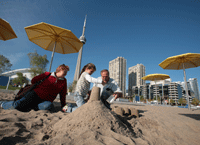
View of HtO’s urban beach showing how the space is enjoyed by people of all ages. (Photo: Jan Becker)
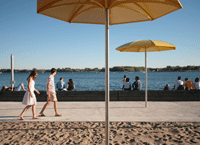
People enjoy coming to the park as it offers unobstructed views of Lake Ontario and opportunities for relaxation. (Photo: Jan Becker)
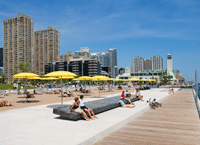
View of HtO east show boardwalk and a slab bench, demonstrating opportunities for flexible seating within the park. (Photo: Jan Becker)
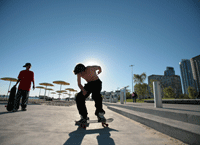
View of HtO east showing the park’s multi-functional nature: people enjoy the paved surface for skateboarding and rollerblading. (Photo: Jan Becker)
"The landscape architect has helped Toronto reclaim its lakefront with strong, bold graphic moves. Summer is precious there and this project makes the most of it. It works just as well in the winter, it's completely flexible."
— 2009 Professional Awards Jury

View of sodded berms at HtO east showing the “multi-use” aspect of the design. (Photo: Neil Fox)

People enjoy the topography of the park; especially the playfulness of HtO’s sodded berms. (Photo: Jan Becker)
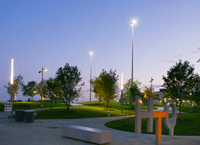
HtO has a branded identity. The name is a play on the formula for water where water and Toronto come together. (Photo: Neil Fox)
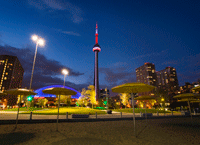
Night view of HtO. The park is also iconic at night time due to its dramatic and colourful lighting scheme, which also ensures greater safety. (Photo: Neil Fox)

View of HtO in the winter time. People still stroll through the urban beach despite cold water. (Photo: JRA)

View of berms at HtO west during the winter time. (Photo: JRA)
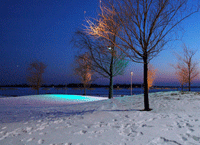
Night view of HtO in the winter time showing how the lights and trees reflect against the snow, adding interest on the park. (Photo: JRA)



